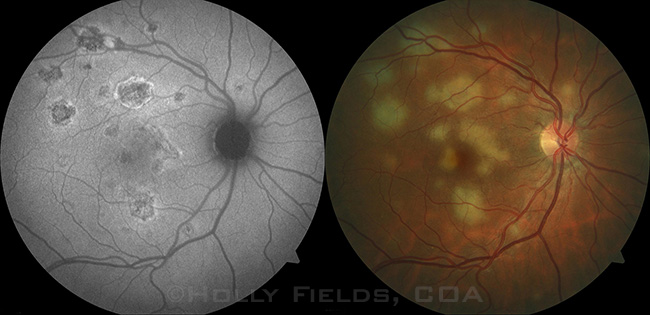Blink
Acute Posterior Multifocal Placoid Pigment Epitheliopathy
By Daniel K. Bennett, MD, and photographed by Holly Fields, COA, North Carolina Retina Associates, Raleigh, N.C.
Download PDF

A 34-year-old white woman presented with a one-week history of blurry vision and “black spots” in her vision. She also reported one week of headaches that began concurrently with the visual changes. On exam, her visual acuity was 20/25 in both eyes, and she had no afferent pupillary defect. There was no anterior chamber inflammation, but 1+ vitreous cells were present in both eyes. Of note, she was 11 weeks postpartum and breastfeeding at the time of presentation, so she declined fluorescein angiography.
This is a case of acute posterior multifocal placoid pigment epitheliopathy (APMPPE), an idiopathic inflammatory condition affecting the retinal pigment epithelium. Because APMPPE can be accompanied by cerebral vasculitis, she was sent for neurologic evaluation but was found not have the latter condition. Optical coherence tomography showed subretinal fluid in her right eye; thus, after consulting with her ob/gyn and the pediatrician, we started the patient on 60 mg daily of oral prednisone, which was tapered over a period of six weeks. Her symptoms resolved over this time period, and she has had no recurrence. Her vision returned to 20/20 in both eyes.
| BLINK SUBMISSIONS: Send us your ophthalmic image and its explanation in 150-250 words. E-mail to eyenet@aao.org, fax to 415-561-8575, or mail to EyeNet Magazine, 655 Beach Street, San Francisco, CA 94109. Please note that EyeNet reserves the right to edit Blink submissions. |